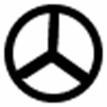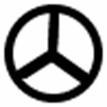
Which of the following is Dalton’s symbol for carbon?
(A)

(B)

(C)

(D) None of the above



Answer
492.6k+ views
Hint: Dalton used them singly to represent elements and in combination to show compounds. Dalton's symbol for an element represented the 'element' as well as 'one atom' of that element.
Complete step by step solution:
-Dalton’s atomic theory was a scientific theory on the nature of matter put forward by the English physicist and chemist John Dalton in the year 1808. It stated that all matter was made up of small, indivisible particles known as atoms. The postulates of Dalton’s atomic theory are listed as:
-All matter is made up of tiny, indivisible particles called atoms.
-All atoms of a specific element are identical in mass, size, and other properties. However, atoms of different elements exhibit different properties and vary in mass and size.
-Atoms can neither be created nor destroyed. Furthermore, atoms cannot be divided into smaller particles.
-Atoms of different elements can combine with each other in fixed whole-number ratios in order to form compounds.
-Atoms can be rearranged, combined, or separated in chemical reactions.
 It is the symbol proposed by Dalton for carbon metal atoms.
It is the symbol proposed by Dalton for carbon metal atoms.
 This symbol represents the phosphorus atom.
This symbol represents the phosphorus atom.
 This symbol represents the potassium atom.
This symbol represents the potassium atom.
Thus, (A) right answer represents the carbon atom.
Note: Dalton was the first scientist to use the symbols for elements in a very specific sense. Berzelius suggested that the symbols of elements be made from one or two letters of the name of the element. There are some limitations also considered in this theory.
Complete step by step solution:
-Dalton’s atomic theory was a scientific theory on the nature of matter put forward by the English physicist and chemist John Dalton in the year 1808. It stated that all matter was made up of small, indivisible particles known as atoms. The postulates of Dalton’s atomic theory are listed as:
-All matter is made up of tiny, indivisible particles called atoms.
-All atoms of a specific element are identical in mass, size, and other properties. However, atoms of different elements exhibit different properties and vary in mass and size.
-Atoms can neither be created nor destroyed. Furthermore, atoms cannot be divided into smaller particles.
-Atoms of different elements can combine with each other in fixed whole-number ratios in order to form compounds.
-Atoms can be rearranged, combined, or separated in chemical reactions.



Thus, (A) right answer represents the carbon atom.
Note: Dalton was the first scientist to use the symbols for elements in a very specific sense. Berzelius suggested that the symbols of elements be made from one or two letters of the name of the element. There are some limitations also considered in this theory.
Recently Updated Pages
Master Class 11 Economics: Engaging Questions & Answers for Success

Master Class 11 Business Studies: Engaging Questions & Answers for Success

Master Class 11 Accountancy: Engaging Questions & Answers for Success

Master Class 11 English: Engaging Questions & Answers for Success

Master Class 11 Computer Science: Engaging Questions & Answers for Success

Master Class 11 Maths: Engaging Questions & Answers for Success

Trending doubts
State and prove Bernoullis theorem class 11 physics CBSE

1 ton equals to A 100 kg B 1000 kg C 10 kg D 10000 class 11 physics CBSE

State the laws of reflection of light

One Metric ton is equal to kg A 10000 B 1000 C 100 class 11 physics CBSE

Difference Between Prokaryotic Cells and Eukaryotic Cells

1 Quintal is equal to a 110 kg b 10 kg c 100kg d 1000 class 11 physics CBSE




